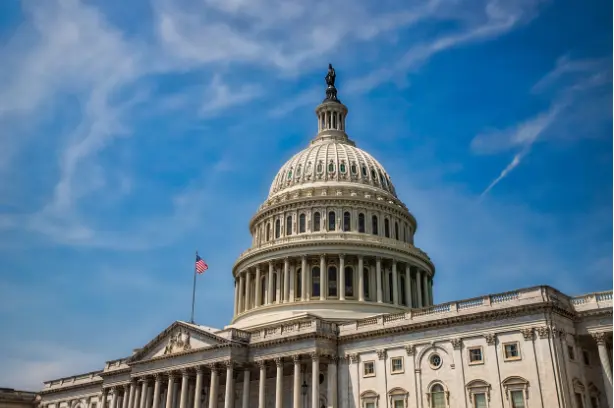By Preserve Gold Research
In March, billionaire investor Ray Dalio took to the world stage with a stark warning: the American economy stands on the brink of a major crisis. Speaking with an urgency born of decades of studying financial cycles, the Bridgewater Associates founder painted a grim picture of a nation drowning in debt. His message was as clear as it was chilling—a downturn is all but imminent. Dalio’s warnings have been echoed by other financial experts, like JPMorgan CEO Jamie Dimon, who warned that the next financial crisis could be even more severe than the last. “It is a cliff, we see the cliff,” Dimon said, referring to the current state of the economy. “It’s about 10 years out, we’re going 60 miles an hour [toward it].” The question now is not if but when and how severe the storm will hit.
The financial titan’s prescient predictions have sent shivers through Americans who are already uneasy about their economy. In his blunt, hard-nosed style, Dalio itemized the factors contributing to the crisis, including crippling levels of government debt, chronic deficits, and persistent inflation. According to the hedge fund chief, geopolitical tensions and the rise of populism have added fuel to the fire, creating a toxic mix of economic and political instability. Drawing parallels to past calamities like the 2008 financial crash and even the upheavals of the 1930s, Dalio insisted that this is no ordinary moment. It’s a narrative of gathering dangers, with America at the center of a looming economic tempest.
A Mountain of Debt at its Tipping Point
America’s debt mountain was the first and most urgent risk Dalio spotlighted—and for good reason. The US national debt has climbed steadily for decades, standing at over $36 trillion today. That’s over $70,000 for every man, woman, and child in the country. Since the 2008 crisis, the nation’s debt has more than tripled, making America the most indebted nation on earth by a wide margin. The red ink has accumulated at a staggering rate, rising by nearly $200 billion every month over the last year alone. Now well above the nation’s annual economic output, the federal debt has ballooned to historic highs as the government’s print-and-spend policies have careened out of control.
In 2024, the US debt-to-GDP ratio surged past 124%—a level not seen since World War II. This means that the United States owes more than its entire gross domestic product, or the value of all goods and services produced in a year. “We have a very severe supply and demand problem. Some people think we’ll handle it because we’ve handled it so far. I don’t think they understand the mechanics of debt,” Dalio cautioned. The “mechanics of debt” Dalio is referring to are the dynamics of debt crises that have played out throughout history. The US government must continuously sell huge volumes of Treasury bonds to finance its deficit spending—but investors’ appetite for that debt is not limitless. Each year of deficit adds more “plaque” to the financial system’s arteries, as Dalio puts it, bringing the country closer to a heart attack.
Today, America’s annual budget deficit hovers around 7.2 percent of GDP, a level typically seen only in wartime or deep recessions. In Dalio’s view, the gap between spending and revenue must be cut by more than half—down to about 3 percent of GDP—just to stop the debt from spiraling higher. “That’s a big deal,” he said of the drastic fiscal belt-tightening required. “You are going to see shocking developments in terms of how that’s going to be dealt with,” Dalio warned. But Dalio foresees an inflection point in the future. At some stage, he argues, the government will have to “sell a quantity of debt that the world is not going to want to buy.” When that day comes, it will mark an “imminent” crisis of “paramount importance,” he added.
The Imminent “Debt Heart Attack”
In Dalio’s view, the nation could be headed for a debt “heart attack”—a sudden seizure of the financial system under the weight of federal debt. If Washington does not change course, a full-blown debt crisis could strike in the not-too-distant future. When pressed for specifics, Dalio admitted, “I can’t tell you exactly when it’ll come, it’s like a heart attack. You’re getting closer. My guess would be three years, give or take a year, something like that.” This puts the potential breakdown somewhere around 2026 to 2028 without any major changes in the current trajectory.
Wall Street veterans haven’t been able to help but recall 2008 when credit markets suddenly froze and brought the economy to its knees. But Dalio suggests that this time could be even more dire. In 2008, the US crisis stemmed mainly from excesses in the private financial sector—subprime mortgages and bank leverage. The government’s balance sheet was strained but still manageable (total debt was about 68% of GDP in 2008, compared to 122% now). At the time, the Fed was able to slash interest rates to zero and print trillions of dollars to backstop the system, all without igniting inflation. But today, the government itself has become the source of risk, and the Fed’s monetary policy levers are already engaged, leaving little left in the toolkit.
Dalio asserts that the US has entered the later phase of a long-term debt cycle—a phase more akin to the late 1930s-1940s era than to 2008. “When you reach the part of the cycle that you have to borrow money to pay debt service, and the holders of those bonds say it’s a risky situation…we call that the debt death spiral,” Dalio said. According to the Bridgewater Associates founder, this self-reinforcing debt cycle creates a feedback loop of rising debt and borrowing costs that eventually chokes off the borrower’s viability. It’s the same vicious cycle that has crushed hundreds of companies and countries in the past as investors shudder at the thought of losing their investment—further driving up borrowing costs. Today, Dalio warns that the world’s largest economy has been flirting with the same perilous fate.
Economic Imbalances and Fiscal Erosion
Beyond the sheer size of the debt, Dalio has highlighted the dangerous economic imbalances feeding into the crisis, with chronic deficit spending at the heart of it. The US government has been spending far beyond its means for years—and 2024 only worsened that trend. In the fiscal year that just ended, the federal deficit neared $2 trillion, despite the economy not being in recession. According to Dalio, this is unusual, as deficits typically shrink when unemployment is low (as it was in 2024). Instead, the US ran an enormous deficit even in “good” times, a clear sign of a “structural imbalance.”
When the government consistently spends more than it takes in, it must borrow to fund its obligations—paying interest on that debt and adding to its total liabilities. However, the Treasury has had to borrow huge sums to stimulate a crisis-hit economy (as in 2020), and even in normal times, due to politically difficult choices around taxes and spending. As a result, interest payments have surged and now represent the fastest-growing item in the federal budget. In the first five months of the fiscal year 2025, interest outlays were 13% higher than a year earlier. By 2035, the Congressional Budget Office (CBO) estimates they will nearly double their 2024 level, reaching $1.8 trillion.
Adding to the concern is that the US has been running budget deficits for most of the last six decades, and breaking old habits is no easy task. Given the budget process’s political nature, experts have warned that finding consensus on how to fix the deficit will require a herculean effort. Meanwhile, rising interest rates haven’t helped matters. Dalio warns that each additional uptick in interest rates or slowdown in growth could push the US closer to a tipping point, where it will have to choose between a painful recession or seeing its debt spiral out of control.
Inflation and the Risk of a Dollar Crisis
Inflation—the specter that has returned to haunt the US in recent years—was another key piece of Dalio’s warning. While consumer price inflation has moderated from its 2022 peak, Dalio sees persistent inflationary pressures lurking, partly due to the debt dynamics. The logic is sobering: if private and foreign investors won’t buy enough US bonds, then the Federal Reserve may end up printing money to cover the government’s bills, which devalues the dollar and stokes inflation. He warns that this is the classic route to ruin for debtor nations.
A debt crisis can quickly morph into a currency crisis as faith in a nation’s money erodes. Already, the US dollar’s status has been under pressure as the world’s reserve currency. According to International Monetary Fund data, the share of global foreign exchange reserves held in dollars peaked at 73% in 2001, falling to under 60% by 2024. For years, global central banks have been divesting from dollar holdings, turning to time-tested assets like gold instead. Foreign governments—especially those at risk of US sanctions or political pressure—see the weaponizing of the dollar as a major threat to their sovereignty. Led by China and Russia, efforts to de-dollarize the global economy have accelerated in recent years amid rising geopolitical tensions and the increasing use of trade sanctions.
If the dollar’s hegemony were to wane further and fewer Treasuries are sold, Dalio warns that the Fed will face a choice between two painful options: either raise interest rates to attract investors (which could crash the economy) or keep printing money (which would sink the dollar’s value and ignite higher inflation). Either, Dalio says, would be disastrous for average Americans’ savings and living costs.
Inflation risk is also tied to geopolitical shifts. Globalization has shifted into reverse in recent years, with the US reshoring industry and decoupling from China in critical areas. This has put upward pressure on costs as supply chains are reconfigured and national security concerns start to trump economics in trade relationships. Moreover, shortages and supply shocks could reignite price spikes if trade wars escalate. In light of this, Dalio cautioned that we might not be done with inflation—not by a long shot. If a debt crisis forces the Fed to choose between printing money or letting the government default, history has shown that central banks will nearly always print money. And that could usher in the kind of rapid money decline Americans haven’t seen in living memory, shredding the dollar’s remaining purchasing power.
Geopolitical Tensions: A Dangerous Backdrop
Dalio did not limit his warnings to domestic fiscal issues. He painted a broader picture of rising geopolitical tensions that could exacerbate the already precarious situation. The world has entered a more fragmented and conflict-prone era, he noted, which has made the US economy even more vulnerable. As countries become increasingly nationalistic and protectionist, trade relationships are strained, and supply chains are disrupted. Key relationships and alliances that have underpinned global stability for decades have frayed, and new rivalries have begun heating up.
The Bridgewater Associates co-chairman pointed to the brewing trade and economic battles involving the United States as a key source of concern. For instance, US-China relations continue to deteriorate, with disputes over technology, trade, and Taiwan raising the prospect of a broader confrontation. Meanwhile, the war in Ukraine has already disrupted global markets and forced the West into costly sanctions and defense spending. Even trade tensions with allies and neighbors have been intensifying. Spats between the US and Canada, the US and Mexico, and the US and the European Union have all threatened to disrupt vital trade flows at a time when global growth is already slowing. Tariffs and protectionist policies have come back in fashion worldwide, echoing the beggar-thy-neighbor policies of the 1930s.
Dalio warned that these tensions could lead to serious global repercussions. Economic conflicts like tariff battles not only strain international relations but also act as hidden taxes that fuel inflation. For debt-laden economies, such shocks could increase the risk of collapse. The hedge fund titan was careful to clarify he wasn’t necessarily predicting World War III tomorrow. Rather, he emphasized that economic warfare was a real risk—countries using financial levers as weapons. The US itself has wielded the dollar-based financial system as a tool against adversaries on several occasions (like cutting off Russia’s access or sanctioning Chinese companies). But, as Dalio warns, this could backfire in the long run by serving as an impetus for countries to establish alternative systems that would diminish the US’s global influence.
Dalio also alluded to internal tensions within the US, particularly regarding political polarization. Although he didn’t dive deeply into US domestic politics, the undertone was apparent. Political polarization and conflict at home can impair a country’s ability to respond to crises. In his previous writings, Dalio warned of a “civil-war-like” internal conflict risk in the US by the late 2020s, driven by widening wealth gaps and ideological divides. While not explicitly mentioned in his March 2025 talk, the specter of domestic tensions looms over the economic warnings. A government paralyzed by infighting or lurching between policy extremes would struggle to fix the debt problem.
Like dry brush waiting for a match, these geopolitical and social tensions could erupt into a global conflagration of economic instability. An external shock—say, a new war or a major diplomatic rupture—could be all it takes to ignite the tinderbox. And with no shortage of potential flashpoints today, the risk of such a scenario is hard to ignore.
No Comfort, Only Warnings
Dalio’s warnings may seem distant and abstract for everyday Americans—the stuff of Wall Street boardrooms or far-off political conflicts. But the truth is that the consequences of unchecked debt and geopolitical instability can trickle down to the average citizen. Taxpayers could be left to bear the brunt of budget cuts and soaring interest costs. Social programs that millions depend on could face deep reductions, and the cost of living could rise as the economy reels from shocks.
Retirement savings once thought to be secure, could be wiped away as inflation erodes the value of hard-earned investments. Homeowners and small business owners could face the risk of rising interest rates, which could make refinancing or borrowing prohibitively expensive. And any economic downturn would likely result in job losses and a general decline in living standards. As bleak as they may seem, these scenarios have played out throughout history.
Unlike some pundits who pair their warnings with optimistic caveats, Dalio offered no soothing platitudes. In his view, America built its current prosperity on a fragile foundation of debt, with little regard for the long-term consequences of its actions. Living on borrowed time and money, the country now finds itself at a crossroads. Unless drastic changes are made, Dalio believes it’s only a matter of time before the precarious balance tips. Yet, making any drastic changes (like slashing deficits by trillions of dollars) would itself be economically painful, potentially plunging the nation into austerity or a recession. It’s a damned-if-you-do, damned-if-you-don’t scenario.
As Dalio pointed out, every great empire or leading economy in history has eventually faced a day of reckoning when debt and imbalances catch up to it. In his view, that day is drawing near for the United States. As the world’s biggest debtor nation, the United States has been able to maintain its status through borrowing and printing money for decades. Every dollar, every loan, and every fiscal decision of past administrations has contributed to a larger story—a story of rise and fall, of caution and consequence. But this game of kick-the-can-down-the-road can only last for so long. Eventually, the laws of economics catch up, and the piper must be paid.







